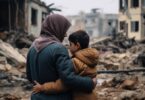The primary goal for humanitarian aid? Save lives and help those who are suffering. Unlike development aid, humanitarian aid tends to focus on immediate needs rather than addressing underlying, more systemic issues. Organizations like the Office for the Coordination of Humanitarian Affairs, the World Health Organization, governments, and countless national and international nonprofits help coordinate aid efforts. What kind of aid are they providing? Here are ten examples:
Disaster relief
Natural disasters are a major cause of the world’s death and suffering. According to the UN Report “Human Cost of Disasters,” there’s been a significant increase in the number of recorded disaster events in the last 20 years compared to the two decades before that. Billions of people have been affected. 2020 included a record-breaking Atlantic hurricane season, earthquakes, flash floods, wildfires, and more. Humanitarian aid in the face of this type of crisis includes shelter, meals, clean water, and more. The Red Cross responds to many disasters around the world.
Shelter
Speaking of shelter, it’s one of the most important aspects of humanitarian aid. It’s often needed when helping people displaced by things like disasters, war, or other conflicts. The UN Refugee Agency is a major distributor of shelters such as tents and plastic sheeting, though their official stance is that they want to avoid camps unless necessary. When creating camps, they have to consider how to keep the environment safe from fires and disease. The safety of women and girls is a high priority, as well. Providing shelter can also include aid like paying for hotel rooms. During the Covid-19 pandemic in the US, 70% of Continuums of Care (local governing bodies that coordinate homelessness services) used hotels at some point in a 5-month span.
Food
Food insecurity is a global issue. Issues like displacement, climate change, and conflict contribute to the problem. In fact, people from conflict-affected countries are three times more likely to suffer from undernourishment. The World Food Programme is the leading humanitarian organization focused on food. In 2020, they provided aid to over 115 million in 84 countries. Each year, they distribute more than 15 billion rations.
Agricultural crisis
Problems with agriculture are closely linked to food insecurity, though aid looks different when it’s focused on the farmers themselves. Famines are a big issue, as well as disruptions due to conflict and diseases that affect crops. Using a 2010 FAO project in Sri Lanka as an example, humanitarian aid for farmers can include vegetable seed kits, home garden kits, barbed wire, water pumps, and livestock.
Water
It doesn’t take people long to get sick or die due to a lack of clean water. According to a 2019 WHO report, a staggering 1 in 3 people can’t access safe water. Women are the most affected by water crises. They’re usually the ones responsible for collecting water for the community, which ends up taking up all their time. This keeps women (and their families) caught in the cycle of poverty. Humanitarian aid includes funds for water systems, filters, and more. This is an example of how meeting an immediate need – safe water – can create better conditions for long-term improvements.
Sanitation
Access to safe water and sanitation are closely linked. WASH – which stands for “water, sanitation, and hygiene” is an essential public health issue in the Sustainable Development Goals. According to the WHO report mentioned above, 2 billion people don’t have access to basic sanitation. ⅓ live in the Least Developed Countries and most are from rural areas. This matters because inadequate sanitation is linked to diseases like intestinal worms and diarrhoeal deaths. Good sanitation systems, toilets, and hygiene education are a few examples of sanitation-focused humanitarian aid.
Medical care
Medical care includes a wide variety of activities, such as pledging funds, materials, and personnel. The Covid-19 pandemic triggered a wave of promises and programs, such as a $2 billion coordinated response plan from the UN. The success of humanitarian aid in the face of such a severe emergency remains to be seen. Past examples of medical aid include the Guinea worm eradication campaign, which reduced incidences of the disease from 3.5 million in 1986 to 27 in 2020.
Children’s aid
In times of trouble, children are extremely vulnerable. Their human rights are often ignored or outright violated. Because of their lack of influence and power, they need adults to speak up for them. In Yemen, which has been suffering one of the world’s worst humanitarian crises for years, almost 2.3 million children younger than 5 are at risk of acute malnutrition. Organizations like UNICEF, the largest children’s aid organization, focus on providing children with shelter, meals, medicine, and more.
Refugee care
Refugees are vulnerable to just about every humanitarian issue on this list, making them a high priority for aid organizations. The International Rescue Committee has been responding to crises for 80 years. They assist in healthcare, education, and economic well-being. Because women and girls are especially vulnerable, many programs focus on them.
Education
Aid funding has not historically prioritized education. However, the disruption of education or the lack of education access is just as serious as other issues. While education clearly has benefits in the long term, schools are also places where children can have short-term needs met in the form of safe shelter, food, sanitation, and more. Schools often serve as community spaces, too.












